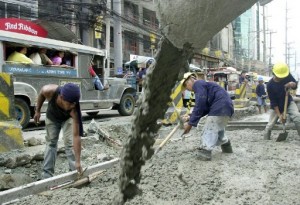A key infrastructure project—an elevated highway meant to decongest Metro Manila’s main thoroughfares of vehicular traffic—has finally received the greenlight from Malacañang, three years after it was first proposed to the Aquino administration.
In a statement, the Department of Transportation and Communications (DOTC) said the presidential palace had recently approved the third stage of the P26.5-billion Metro Manila Skyway project that will connect Sen. Gil Puyat Ave. in Makati City to Balintawak in Quezon City through a 14.2-kilometer, six-lane “connector road.”
The project will be built and fully funded by Citra Central Expressway Corp., a consortium made up of Citra Metro Manila Tollways Corp., its main shareholder San Miguel Corp., and Philippine National Construction Co.
“This new road is expected to help decongest Edsa and other major roads such as Quezon Ave., Araneta Ave., Nagtahan and Quirino Ave. and greatly reduce travel time from [Sen. Gil Puyat Ave.] to Balintawak from the usual two hours or more to just 15 minutes,” the DOTC statement said.
The announcement came a day after an internationally renowned Filipino transportation consultant called for the replacement of the leadership of the transportation department for what he said was its incompetence in executing much-needed transportation and infrastructure programs.
The DOTC said the “flood free” expressway “will help reduce pollution, provide greater comfort and safety to the motorists and result to large savings in travel time, fuel and vehicle maintenance costs.”
It would also provide around 6,000 direct jobs and an additional indirect jobs of about 10,000 during construction, the department added.
The elevated tollway is estimated to be completed in three years as preparatory and advance works will start before the end of 2013. Round-the-clock construction work is expected to begin by the second quarter of 2014.
As conceptualized, the project will connect the Southern Luzon Expressway to the Northern Luzon Expressway. Apart from allowing vehicles—especially cargo trucks and buses—to bypass Edsa or other ground-level Metro Manila roads and move commuters and cargo between north and south faster, private vehicles will also be able to get on or off the tollway through eight strategically located ramps along the route, eliminating the need for them to traverse the heavily congested Edsa.
The project will be overseen by DOTC and the Toll Regulatory Board.
Transportation Secretary Joseph Emilio Abaya said the first section of the roadway from Gil Puyat to Nagtahan might be opened for service by early 2016—a move reminiscent of the inauguration of a small section of what was then a still incomplete Metro Rail Transit line 3 in 1998 during the dying months of the Ramos administration.
“DOTC, along with DPWH, MMDA and local governments of Makati, Manila and Quezon City will surely coordinate and do its best to minimize traffic inconvenience throughout the route of the project.” Abaya said.
In a 2013 report released by the Japan International Cooperation Agency, it was estimated that around P2.4 billion worth of economic and opportunity losses were incurred daily due to the traffic congestion in Metro Manila.


